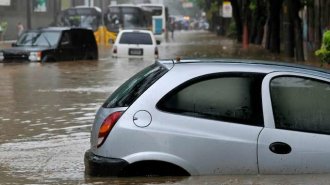
In a used car water damage is something to watch out for. You may be able to purchase a water damaged car for as much as half off a similar vehicle that has not been in a flood or otherwise damaged by water, but water-damaged vehicles are usually required to have a title that reflects that it has been damaged by water. While many cars with some water damage do make excellent values and will run reliably for years, there are some potential problems that you should be aware of.
Electrical Problems in Water Damaged Cars
Often, water damage does not readily present itself to mechanics or car inspectors. Water damage to electrical systems and car computers can often go unnoticed if the damage does not create immediate problems. However, over time, wires and circuits in automobiles may be weakened by corrosion from the water that was once there. Therefore, when purchasing a water damaged vehicle, you should be aware that there may be electrical problems in the future.
Undercarriage and Floor Board Problems
In addition to electrical problems, water damage may have already caused rust on the undercarriage of the vehicle or in the floorboards which may not be easily seen with a cursory inspection. When purchasing a water damaged vehicle, always make sure that you thoroughly inspect the undercarriage and floorboards of the vehicle.
In recent years, there have been as many as half a million flood damaged cars, due to the recent hurricanes in the southern states. What is most alarming however, is that more than half of these cars end up back on the road. The problem with a flood damaged car is that it can be very easy to conceal any traces of damage. You may purchase a car thinking you got a great deal, only to be plagued with a variety of erratic problems and expensive to repair malfunctions. The good news is that no matter how hard someone tries to conceal flood damage, there will always be evidence if you know where to look.
Start in the Most Obvious Places
Sometimes evidence may be hiding in plain sight. The first thing you should do when inspecting a car is to look at the interior. Should the carpeting and upholstery be loosely fitting or newly replaced, this may be a sign that your car has suffered flood damage. Should you see a brand new interior in an older car, always make sure to ask the reasons for the replacement and document the answers. Examine the upholstery for staining or discoloration and check under the carpet for traces of silt as well as any mold or mildew smell.
Water lines, silt or rust around the pedals and underneath the dash are a telltale sign of flood damage. If there is any exposed wiring, lightly flex it, as water damaged wiring will be brittle and prone to cracking. Check inside the engine bay and trunk area, as well as the undercarriage and frame. Look specifically for horizontal lines of discoloration as well as any rust or silt which may indicate a watery history.
Test Everything Twice
Once you have looked the interior over, test the interior electronics. Place the key in the ignition and check to make sure the turn signals, dome lighting, wipers and cigarette lighter function properly. Turn on the ignition and test the radio, air conditioning and heating systems, as well as any power locks or windows. When you're satisfied, check it all over again, as some problems can be intermittent and may not present themselves at first glance.
Check the Paper Trail
As with any used car, running a vehicle history check is especially important. The problem is that it is sometimes possible to erase the evidence from vehicle records. A telltale sign of this will be multiple registrations in different states. This may allow the owner to sneak through loopholes that allow them to omit certain unsavory parts of a car's history.
While just one problem in this list may not mean flood damage, it pays to carefully look for connections. If you see different problems on this list start to appear, it could be an indicator that you may be better off looking for a used car elsewhere.